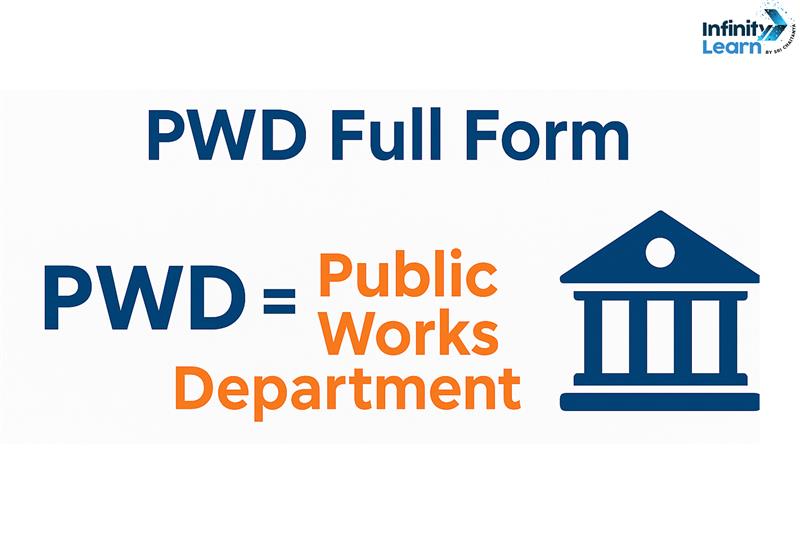Table of Contents
PWD Full Form is Public Works Department. This is a government department. It looks after the building and maintenance of public structures. These include roads, bridges, buildings, and other public places. The Public Works Department is an important part of the state and central government.
The PWD Full Form is often seen on signboards near construction sites. It means that the construction work is being done under the Public Works Department. Every state in India has its own PWD office. There is also a central PWD that works for the government of India.

PWD Full Form
PWD Full Form stands for Public Works Department. It is a part of the government that looks after public works. These works are for the use of all people. The department makes sure that the roads are smooth, buildings are safe, and water supply is working well. The goal of PWD is to help the public by building and caring for useful places and services.
What Does PWD Do?
The PWD Full Form stands for Public Works Department. It plays a big role in building things that are useful for everyone. The main job of PWD is to build and take care of public structures. This includes:
- Roads
- Highways
- Flyovers
- Public schools
- Government buildings
- Hospitals
- Water supply systems
PWD makes sure that these buildings are strong, safe, and clean. If something is broken, PWD repairs it. If something new is needed, PWD builds it.
Do Check: AICTE Full Form
Types of PWD Work
PWD Full Form means Public Works Department, and its work can be divided into different parts:
- Building and Construction PWD builds new government buildings, schools, colleges, hospitals, and courts. It also builds housing for government workers.
- Road and Bridge Maintenance PWD makes roads, highways, and bridges. It also fixes roads if they have holes or cracks.
- Water Supply and Drainage PWD takes care of water pipelines. It makes sure clean water reaches homes and public places. It also manages drainage systems to prevent water logging.
- Electric and Mechanical Work PWD looks after electric lines, street lights, and electric work in government buildings.
Why is PWD Important?
PWD Full Form is Public Works Department. It is important because it helps in making life easy for people. Roads, bridges, and buildings made by PWD are used every day. They help people go to school, hospitals, offices, and markets.
PWD helps in the growth of cities and villages. With good roads and clean buildings, people live better. The department also creates jobs for engineers, workers, and contractors.
Do Check: ADB Full Form
PWD in Different States
The PWD Full Form remains the same in every state. But every state has its own PWD. For example:
- Maharashtra PWD
- Uttar Pradesh PWD
- Tamil Nadu PWD
- Rajasthan PWD
Each state PWD handles the work in its area. They follow the rules of the state government. But all of them work for public good.
Central PWD (CPWD)
The Central Public Works Department is called CPWD. It works under the central government. CPWD builds and looks after buildings of the central government. These can be:
- Parliament House
- Central Government Offices
- Government Quarters
CPWD works in all states of India. It is bigger than state PWDs. It also helps in national projects like big dams and power plants.
Who Works in PWD?
PWD Full Form is Public Works Department. Many people work here. The main workers are:
- Civil Engineers
- Electrical Engineers
- Mechanical Engineers
- Architects
- Contractors
- Site Workers
These people plan, design, and build the projects. They also check the quality of work and finish the task on time.
Do Check: ACC Full Form
How to Get a Job in PWD?
If someone wants to work in PWD, they need to study engineering. After completing studies, they can apply for jobs through:
- State Public Service Commission
- Union Public Service Commission (for CPWD)
- Direct recruitment by PWD
Engineers and other staff are selected through exams and interviews.
Challenges Faced by PWD
PWD Full Form stands for Public Works Department. Like any other department, it faces some challenges:
- Shortage of staff
- Delay in projects
- Weather problems during construction
- Lack of funds
Still, the department tries its best to complete all work on time and keep public places safe and clean.
Role of PWD During Disasters
During floods, earthquakes, or storms, the PWD Full Form – Public Works Department – becomes very important. It helps in repairing roads and buildings quickly. It also builds shelters and helps in rescue work.
Do Check: ABG Full Form
Conclusion
PWD Full Form is Public Works Department. It is one of the oldest and most useful departments in India. It builds and maintains important structures like roads, schools, hospitals, and offices. Every state has its own PWD. There is also a central PWD for the country. The work of PWD helps in the growth and progress of the nation.Whether it is building a new road or repairing an old hospital, the Public Works Department is always there to help. Its role in everyday life is big, and it continues to grow with time.








